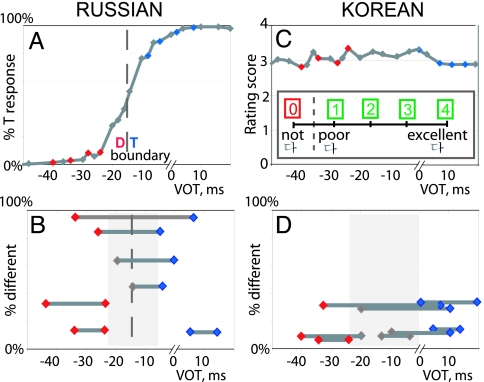Fig. 2.
Results from behavioral tests for Russian speakers (n = 13, mean age 25.6) and Korean speakers (n = 13, mean age 28.8). In each language, 0-ms VOT in the figures represents the “basic” token for that language (see Materials and Methods). (A) Russian speakers showed a classic identification function for syllables along the /da/-/ta/ VOT continuum with a crossover point at around −16-ms VOT. (B) Russian speakers more successfully discriminated syllable pairs when the members of the pair fell on opposite sides of the category boundary, relative to equidistant pairs of syllables that fell on the same side of the category boundary. (C) In contrast, Korean speakers showed no evidence of categorical perception in either task. In the naturalness rating task, they rated all syllables along the VOT continuum as equally natural instances of  /Ta/, for contextually natural positive VOTs and contextually unnatural negative VOTs alike. (D) Discrimination accuracy among Korean speakers was generally low. Unlike Russian, discrimination accuracy was better predicted by the acoustic distance between the sounds in each pair, rather than by the categorical status of the two sounds. In A and C, the four tokens indicated by blue and red represent the [ta] and [da] sounds used for the MEG experiment in each language. In B and D, the shaded area represents the gap between the standard and deviant categories in the MEG experiment.
/Ta/, for contextually natural positive VOTs and contextually unnatural negative VOTs alike. (D) Discrimination accuracy among Korean speakers was generally low. Unlike Russian, discrimination accuracy was better predicted by the acoustic distance between the sounds in each pair, rather than by the categorical status of the two sounds. In A and C, the four tokens indicated by blue and red represent the [ta] and [da] sounds used for the MEG experiment in each language. In B and D, the shaded area represents the gap between the standard and deviant categories in the MEG experiment.

